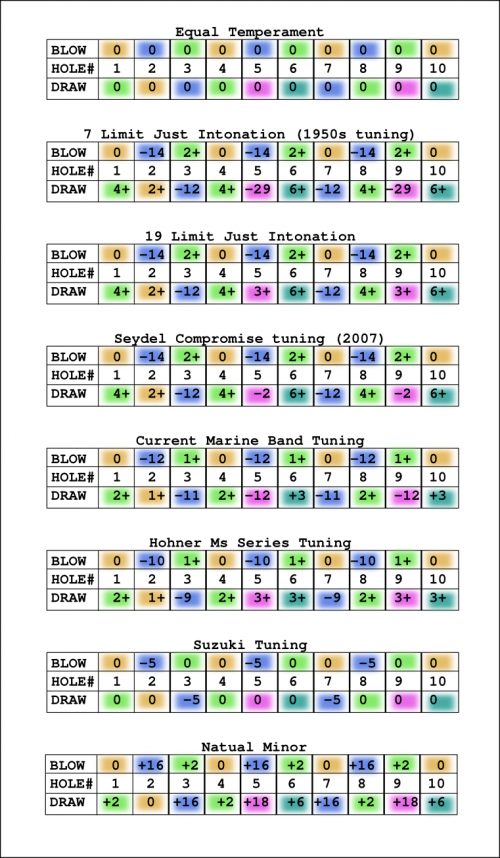arzajac
992 posts
Feb 24, 2013
5:15 PM

|
A harp that's in tune really has some mojo. I use this method to save time. I get great results. I put all the details on this page:
http://harp.andrewzajac.ca/Tune
----------

|
Littoral
794 posts
Feb 25, 2013
7:33 AM

|
Much thanks. I think I understand this. It's the math that I have to read 5 times to convince myself. Just not my forte. I can't find where to change the baseline pitch on my tuner. I'm using the free gstrings app on my phone. It's good but I'd be much better at tuning if I changed the pitch reference. I keep counting +- cents and lose track of where I am. Is there a decent phone app that does this? I'll buy a decent tuner but it just seems like there ought to be a good app that will do it.
|
Greyowlphotoart
1136 posts
Feb 25, 2013
7:43 AM

|
Thanks for that very informative article. I feel like I would be able to give this a try.
----------

Grey Owl YouTube
Grey Owl Abstract Photos
|
isaacullah
2343 posts
Feb 25, 2013
8:22 AM

|
That's some great advice. It's going in the archive with the Pat Missin, Dave Payne, and BBQ Bob tuning advice I've amassed over the years.
The unique addition from you will be the idea about setting the tuner's Htz ratio to the intonation of the specific note in the tuning layout rather than leaving it A=442 and trying to "guess" how many cents sharp/flat you are from the wiggling needle. That is simple, but brilliant! I can't believe I've been doing it the stupid way all these years when there is such a simple way to solve that guessing! :)
----------

View my videos on YouTube!
Check out my songs on Soundcloud!
Visit my reverb nation page!
|
lor
176 posts
Feb 25, 2013
8:32 AM

|
I believe it was Albert Einstein who said something to the effect that the most elegant solution to a problem is the simplest.
I see genius in your solution, Andrew.
Thank you.
|
arzajac
993 posts
Feb 25, 2013
9:03 AM

|
Thanks! But I can't take the credit. I just put together bits and pieces and nuggets of great information that others have given out over the years.
----------

Last Edited by arzajac on Feb 25, 2013 9:05 AM
|
Kingley
2350 posts
Feb 25, 2013
10:06 AM

|
Cool resource. Thank you Arzajac
|
ElkRiverHarmonicas
1509 posts
Feb 25, 2013
12:38 PM

|
That's a great contribution there that you have made Andrew. Very simple and easy to read. I'm sure the illustrations will be very helpful to many.
@Isaac: The concept of tuning using various reference pitches, instead of cents flat or sharp of the reference pitch, isn't anything new. Wally Peterman has probably been doing it this way for 50 years. Wally was my tuning mentor and I never once heard him say the word "cents" unless it was "I remember when harmonicas cost ___ dollars and ____ cents" or something.
One thing I'll add to what you have there, on a minor tuned harp, to tune a minor chord, it should look like this:
Reference pitch 442
1 blow 441, needle to the right just a hair.
2 blow 443, needle to the right a little.
3 blow, 442 needle in the middle.
So, why is the minor chord different?
A: Because there is something wrong with the major chord and it's tuned as it is to diminish that problem.
The problem is the 3rd and 5th (2 blow and 3 blow) sound like crap played together.
When you play those two notes, you get three or four different tones. They're all OK, except for this really trebly one that's really hard on the ears. That Nasty-Ass tone is created because those two notes are very close together, they are only 1 1/2 steps apart (the 1st and 3rd are 2 steps apart, far enough to get along).
So to get rid of that closeness, the 2 blow and 3 blow are moved farther apart. The two blow goes pretty flat and the 3 blow a little sharp. Let's say you tune the 2 blow 14 cents flat and the three blow three cents sharp. Now, instead of 1.5 steps apart, they are 1.67 steps apart (I think that's right) and it diminishes that nasty tone.
On the minor, the third is flatted. So now they are two steps apart. The first and third are 1.5 steps apart, so the root is actually flatted a little and the third sharpened a little to increase that distance, although it doesn't have have a nasty-ass third tone like the 3rd and 5th do... I don't know why, but it's one of the reasons minor chords sound so pretty.
----------
David
____________________
At the time of his birth, it was widely accepted that no one man could play that much music so well or raise that much hell. He proved them all wrong.
R.I.P. H. Cecil Payne
----------
David
Elk River Harmonicas
  Last Edited by ElkRiverHarmonicas on Feb 25, 2013 12:42 PM
Last Edited by ElkRiverHarmonicas on Feb 25, 2013 12:42 PM
|
isaacullah
2346 posts
Feb 25, 2013
3:56 PM

|
@Dave: lol! I meant "unique" to my little store house of tuning knowledge! But I love learn all about the "descent" of harp knowledge, so that info about Wally Peterman is most welcome! Thanks also for the extrea info on minor tuned harps. I've got quite a few of those'so I'm sure that'll come in very handy!
----------

View my videos on YouTube!
Check out my songs on Soundcloud!
Visit my reverb nation page!
|
ElkRiverHarmonicas
1510 posts
Feb 25, 2013
7:22 PM

|
Andrew, I'd be interested how you came by the tuning by reference pitch only. Wally is the only person I know of who talks in those terms.
----------
David
____________________
At the time of his birth, it was widely accepted that no one man could play that much music so well or raise that much hell. He proved them all wrong.
R.I.P. H. Cecil Payne
----------
David
Elk River Harmonicas
 
|
arzajac
994 posts
Feb 26, 2013
3:24 AM

|
Hi Dave. Thanks!
I remember a post on this forum from Joe Spiers who described this to Frank.
Eliminating beating by varying breath force is straight from Pat Missin's page although I made the flowchart myself. (I used to write it down on a scrap paper on my workspace because I would constantly get confused and tune the reed the wrong way!)
Sneaking up on the pitch by aiming for 50 half way is pretty much my idea, but that's how I approach a lot of things.
The big revelation tuning-wise was when I discovered that the "bunch of numbers" found on the internet - the tuning offsets from ET) are only a recipe.
There are many ways of making a dish. And if you prepare a dish without following the recipe, or make some changes to the recipe, it can still be a great dish.
Somebody somewhere first made that dish without the recipe. The recipe is just one way to describe the dish.
So, with respect to tuning, if you want to move from ET to a compromise, the first ingredient would be to lower the thirds. You can do that to taste... Suzuki, Crossover, MB all do it differently. If you want it to sound more compromised, raise the fifths, adjust the flat-seventh to your taste, etc...
----------

Last Edited by arzajac on Feb 26, 2013 3:25 AM
|
Sherwin
29 posts
Feb 26, 2013
6:26 AM

|
Thanks Arzajak,,,,,,ah tuning the last frontier
Gonna give this a go on a few harps that are otherwise all done in terms of being set up for playability,,got a good feeling my tuning skills will improve considerably starting today. I've been at it a lot lately, and with less and less struggle as I go.
Just what I needed, a fresh way of looking at the task of tuning harps.
Sherwin
|
ElkRiverHarmonicas
1512 posts
Feb 26, 2013
10:50 AM

|
And when you are tuning a chord by ear, you are basically tuning two relationships at a time.. and primarily adjusting these sounds:
The pulse. The pulse comes from the relationship of the 1st and third. The distance between them varies the speed of the pulse.
The undesireable overtone from the 3rd and 5th. The farther apart they are, the more that tone is diminished.
----------
David
____________________
At the time of his birth, it was widely accepted that no one man could play that much music so well or raise that much hell. He proved them all wrong.
R.I.P. H. Cecil Payne
----------
David
Elk River Harmonicas
 
|
Sherwin
31 posts
Feb 28, 2013
9:30 AM

|
Arzajak, I tuned a harp using the method you suggested and found it considerably easier than: reading cents, following cents deviation chart.
The approach just seems right.
I'm happy with the results, I'll go over the same harp in a couple of days and retune as necessary.
Thanks......Sherwin
|
arzajac
998 posts
Mar 03, 2013
8:36 AM

|
Here's a visual representation of some Richter tuning options.

I'm a visual person so this sort of thing helps me grasp the subtle differences between various compromise tunings.
----------

Last Edited by arzajac on Mar 03, 2013 8:38 AM
|
barbequebob
2212 posts
Mar 04, 2013
8:02 AM

|
@arzajac -- You need to correct that chart where you've just listed Hohner comprimise tuning because what you're showing is the one Seydel uses and Hohner uses 3 different comprimise tunings that are entirely different.
----------
Sincerely,
Barbeque Bob Maglinte
Boston, MA
http://www.barbequebob.com
CD available at http://www.cdbaby.com/cd/bbmaglinte
|
arzajac
999 posts
Mar 04, 2013
9:20 AM

|
Hi Bob.
Well... The chart is not wrong. There are no values on it. Yes, Seydel tuning is closer to 19-limit than current Marine Bands, but that's not the point. I wanted to show a spectrum from ET to JI.
I picked "a" Hohner tuning, not "the" Hohner tuning. The colors are qualitative anyway - that's the real point.
I could have used four Hohner tunings, too, now that you made me thing of it. I could have gone from GM, to Crossover, to MS to 1950s Marine Band.
My thinking of more in line with the fact that it's so simple to go from ET to Suzuki compromise. And if you want more distance from ET, you can grab some elements from 19-Limit. Like a buffet.... That's why I mention "Similar to 19-Limit"...
----------

Last Edited by arzajac on Mar 04, 2013 9:31 AM
|
timeistight
1145 posts
Mar 04, 2013
10:02 AM

|
What are he differences between the various Hohner compromise tunings. In particular, how does the Crossover tuning differ from 19-limit JI?
----------
Playing music... it's a privilege.
Kim Wilson
Last Edited by timeistight on Mar 04, 2013 10:03 AM
|
arzajac
1000 posts
Mar 04, 2013
10:11 AM

|

The Crossover tuning values change a little according to they key. I think of the Crossover as tuned to 443 on the blow and 444 on the draw, which puts the thirds at -5, the fifths at +1 and the flat sevenths at -2. More or less... See here:
Crossover tuning
----------

Last Edited by arzajac on Mar 04, 2013 10:19 AM
|
timeistight
1146 posts
Mar 04, 2013
10:39 AM

|
Thanks, arzajac. Very informative.
----------
Playing music... it's a privilege.
Kim Wilson
|